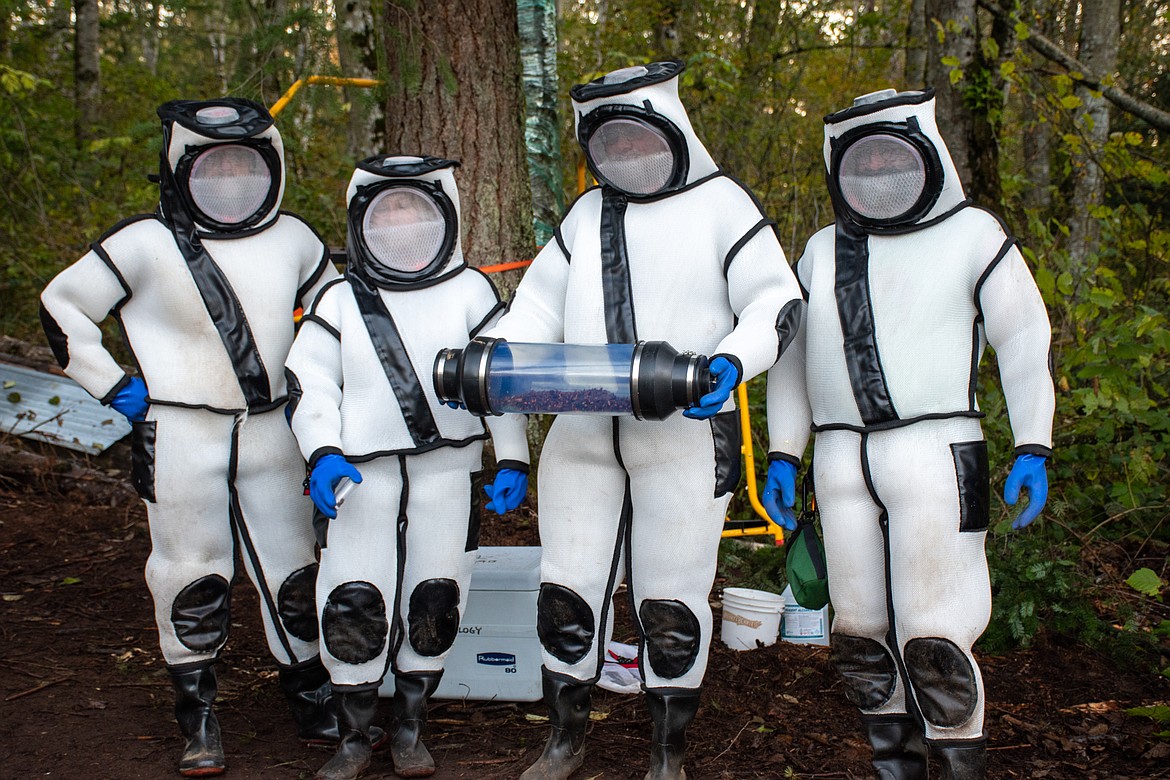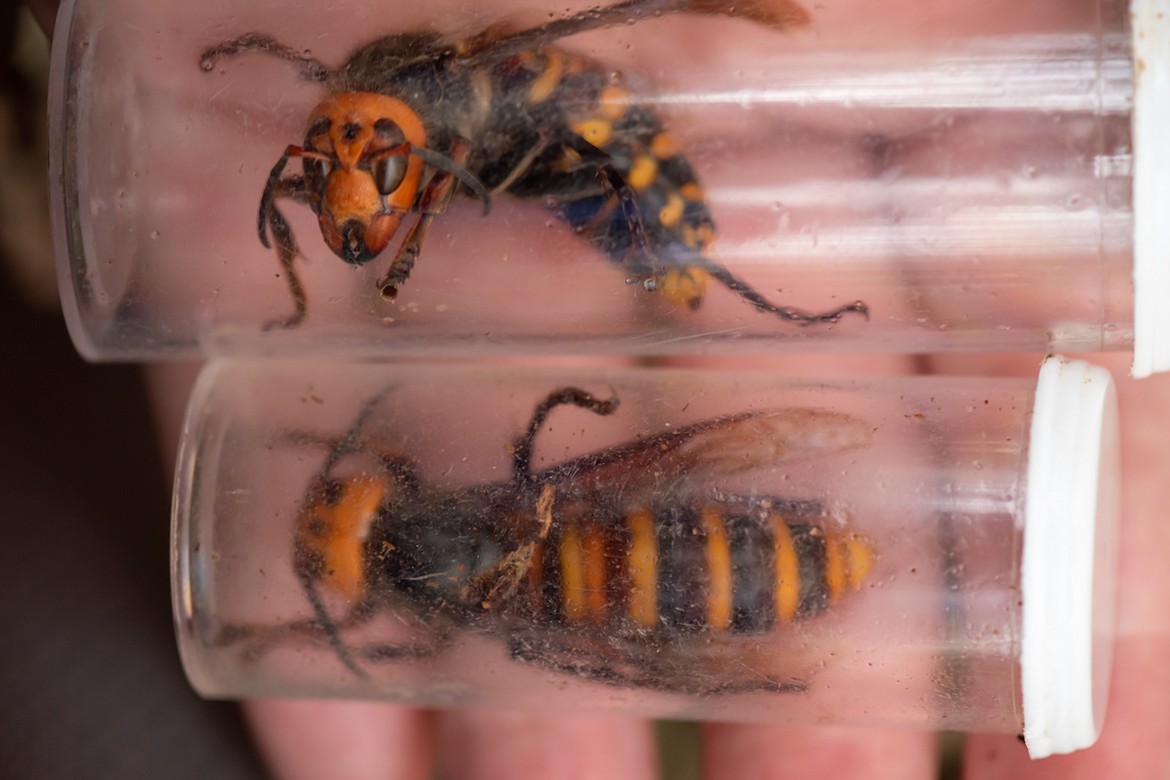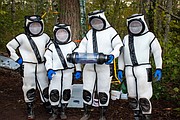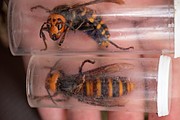Victory in latest battle against Asian giant hornet
BLAINE — It had all the careful planning and coordination of a commando raid.
Because, in essence, it was.
On Saturday, Oct. 24, in a well-rehearsed pre-dawn maneuver, entomologists from the Washington State Department of Agriculture (WSDA), assisted by the U.S. Department of Agriculture (USDA), descended upon a nest of Asian giant hornets, captured or killed them, and destroyed the nest.
“We found one and we took it out, and we’re all pretty happy about that,” said WSDA managing entomologist Sven-Erik Spichiger.
Spichiger said the nest was located after WSDA entomologists captured several live hornets earlier in the week, successfully attached long-range radio trackers borrowed from the USDA, and followed them to the nest, which was located on private property.
WSDA officials have been looking for Asian giant hornet nests since the first specimen was found in the northwest corner of the state near the Canadian border about a year ago, and have tried several times using several different methods over the last two months to capture live specimens and track them.
Asian giant hornets prey on other wasps and honeybees, and can quickly destroy an entire hive. The hornets decapitate all the adult bees and use the larvae as food. Honeybees in Asia, where the hornets are native, have learned to envelope the hornets in a ball of bees, essentially cooking and choking the hornets to death.
The European honeybees of North America, however, have no such defense against the giant hornets, which can reach up to 2 inches in length.
According to WSDA spokesperson Karla Salp, the property owner — who has not been named publicly — did not reach out to the department.
“We just kind of ended up on his property when we followed the hornet,” she said.
Spichiger said the WSDA entomologists were in a hurry to act, since new Asian giant hornet queens are expected to emerge from established nests soon and because the nest they’d located was close to a house.
“The first thing we saw was a children’s playset 20-30 feet from the nest,” he said. “That’s when we knew we had to act immediately.”
Entomologists looked much like astronauts from a 1950s sci-fi film in their thick white suits designed to protect them from the hornets’ quarter-inch stingers as they set up for the raid. However, those stingers can easily penetrate a suit designed to protect against ordinary bee stings, and Asian giant hornets can use those stingers over and over again and can even use them to spray venom.
“They’re fairly dangerous if you go and mess with them,” he said. “There are 20-50 deaths every year in Japan.”
While Spichiger said Asian giant hornets usually nest underground, this nest was located in the hollowed-out trunk of a dead alder tree about nine feet above the ground, requiring entomologists to erect a metal scaffolding to get to the nest.
They then sealed the entrance with foam, wrapped the tree in plastic, scanned it with a thermal camera to see if there was any activity, attached a vacuum hose to the entrance of the nest, and vacuumed up most of the hornets.
“It was extremely cold, which is why the nest was so docile,” he said. “We were never once attacked. We were fortunately able to to seal the entrance up quickly enough and none were able to escape during the eradication.”
Spichiger said the WSDA captured a total of 98 hornets — 85 vacuumed up and 13 caught later, when the hive’s denizens finally awoke to the threat.
“At first, the vacuuming didn’t upset them, so we hit the side of the tree with a two-by-four, and that seemed to work. They started pouring out,” he said.
The WSDA hornet hunters then finished off the hive by flooding it with carbon dioxide, asphyxiating any remaining hornets.
“At this point, we believe everything in the nest to be dead, and we consider this a successful eradication,” he said.
Spichiger said the tree was then resealed with foam, rewrapped with plastic, cut down and hauled off to the WSDA’s lab. Once in the lab, researchers reported finding 190 larvae, six unhatched eggs, nine drones, 75 queens and 26 workers that stayed behind as the others flew out to defend the hive and got vacuumed up.
“The radio tag that led to the nest discovery was also recovered. The dental floss holding the tag to the hornet appeared to have been chewed through, either by the tagged worker hornet, or a nest mate,” Salp said.
“I’d like to give a special thanks to the property owner,” Spichiger said. “Our presence was overwhelming at times, so for tolerating our presence and letting us get our work done.”
The hornets in the vacuum canister looked “quite dead,” Spichiger said, but once they were taken back to the lab and warmed up they sprang right back to angry, buzzing life.
A few of the captured survivors will be kept alive, some going to the USDA for experiments, and the rest donated to land grant universities as dead specimens for their insect collections. While the WSDA has received requests for Asian giant hornet specimens from private collectors, Spichiger said there won’t be enough of them to go around this time.
“That’s pretty much going to do it for all of the specimens collected,” he said.
With the eradication of this one nest, Spichiger said the WSDA believes there are likely one or two more Asian giant hornet nests in the Blaine and Birch Bay areas of Whatcom County, and that the department will keep its hornet traps up until the end November. However, it would take three years of no sightings and no hornets captured in traps before Spichiger said he would be confident the hornets have been completely eradicated from the Pacific Northwest.
“It still looks cautiously optimistic that we are ahead of this,” he said. “But I’m not sure we’re done in the area where we eradicated the nest.”
Spichiger also noted that the battle against the Asian giant hornet is one the WSDA is waging on behalf of the entire country. The giant hornets could probably not find a decent home in the rolling, arid plains of the Columbia Basin, but other parts of the United States may provide the hornets with a much more inviting home.
“This is a fight for the rest of the country,” he said. “The hornet is well suited to anywhere east of the Mississippi River.”
Charles H. Featherstone can be reached at cfeatherstone@columbiabasinherald.com.






